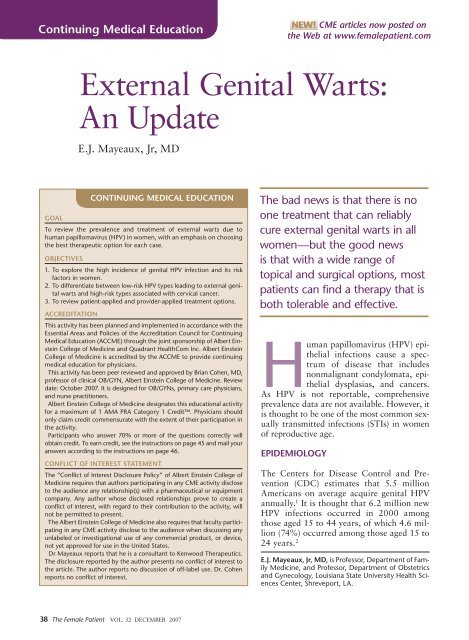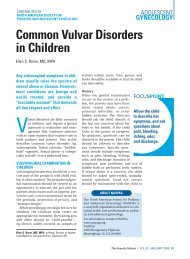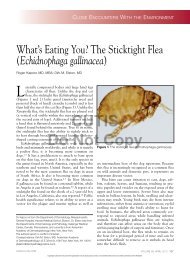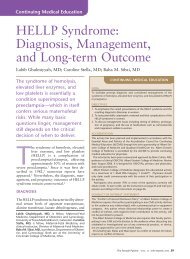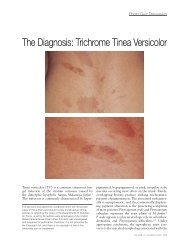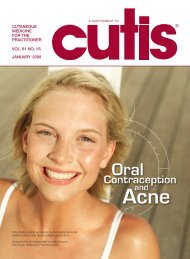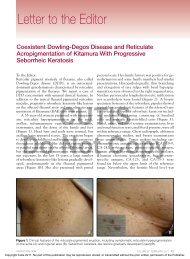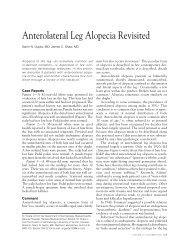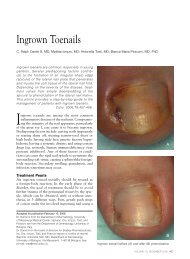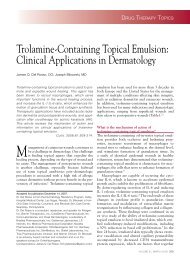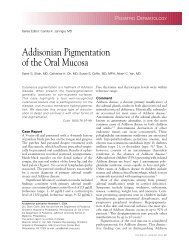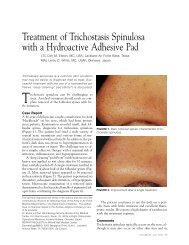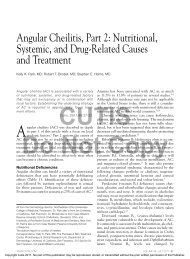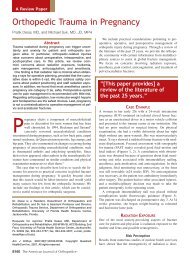External Genital Warts: An Update
External Genital Warts: An Update
External Genital Warts: An Update
Create successful ePaper yourself
Turn your PDF publications into a flip-book with our unique Google optimized e-Paper software.
Continuing Medical Education<br />
NEW! CME articles now posted on<br />
the Web at www.femalepatient.com<br />
<strong>External</strong> <strong>Genital</strong> <strong>Warts</strong>:<br />
<strong>An</strong> <strong>Update</strong><br />
E.J. Mayeaux, Jr, MD<br />
GOAL<br />
To review the prevalence and treatment of external warts due to<br />
human papillomavirus (HPV) in women, with an emphasis on choosing<br />
the best therapeutic option for each case.<br />
OBJECTIVES<br />
1. To explore the high incidence of genital HPV infection and its risk<br />
factors in women.<br />
2. To differentiate between low-risk HPV types leading to external genital<br />
warts and high-risk types associated with cervical cancer.<br />
3. To review patient-applied and provider-applied treatment options.<br />
ACCREDITATION<br />
CONTINUING MEDICAL EDUCATION<br />
This activity has been planned and implemented in accordance with the<br />
Essential Areas and Policies of the Accreditation Council for Continuing<br />
Medical Education (ACCME) through the joint sponsorship of Albert Einstein<br />
College of Medicine and Quadrant HealthCom Inc. Albert Einstein<br />
College of Medicine is accredited by the ACCME to provide continuing<br />
medical education for physicians.<br />
This activity has been peer reviewed and approved by Brian Cohen, MD,<br />
professor of clinical OB/GYN, Albert Einstein College of Medicine. Review<br />
date: October 2007. It is designed for OB/GYNs, primary care physicians,<br />
and nurse practitioners.<br />
Albert Einstein College of Medicine designates this educational activity<br />
for a maximum of 1 AMA PRA Category 1 Credit. Physicians should<br />
only claim credit commensurate with the extent of their participation in<br />
the activity.<br />
Participants who answer 70% or more of the questions correctly will<br />
obtain credit. To earn credit, see the instructions on page 45 and mail your<br />
answers according to the instructions on page 46.<br />
CONFLICT OF INTEREST STATEMENT<br />
The “Conflict of Interest Disclosure Policy” of Albert Einstein College of<br />
Medicine requires that authors participating in any CME activity disclose<br />
to the audience any relationship(s) with a pharmaceutical or equipment<br />
company. <strong>An</strong>y author whose disclosed relationships prove to create a<br />
conflict of interest, with regard to their contribution to the activity, will<br />
not be permitted to present.<br />
The Albert Einstein College of Medicine also requires that faculty participating<br />
in any CME activity disclose to the audience when discussing any<br />
unlabeled or investigational use of any commercial product, or device,<br />
not yet approved for use in the United States.<br />
Dr Mayeaux reports that he is a consultant to Kenwood Therapeutics.<br />
The disclosure reported by the author presents no conflict of interest to<br />
the article. The author reports no discussion of off-label use. Dr. Cohen<br />
reports no conflict of interest.<br />
The bad news is that there is no<br />
one treatment that can reliably<br />
cure external genital warts in all<br />
women—but the good news<br />
is that with a wide range of<br />
topical and surgical options, most<br />
patients can find a therapy that is<br />
both tolerable and effective.<br />
Human papillomavirus (HPV) epithelial<br />
infections cause a spectrum<br />
of disease that includes<br />
nonmalignant condylomata, epithelial<br />
dysplasias, and cancers.<br />
As HPV is not reportable, comprehensive<br />
prevalence data are not available. However, it<br />
is thought to be one of the most common sexually<br />
transmitted infections (STIs) in women<br />
of reproductive age.<br />
EPIDEMIOLOGY<br />
The Centers for Disease Control and Prevention<br />
(CDC) estimates that 5.5 million<br />
Americans on average acquire genital HPV<br />
annually. 1 It is thought that 6.2 million new<br />
HPV infections occurred in 2000 among<br />
those aged 15 to 44 years, of which 4.6 million<br />
(74%) occurred among those aged 15 to<br />
24 years. 2<br />
E.J. Mayeaux, Jr, MD, is Professor, Department of Family<br />
Medicine, and Professor, Department of Obstetrics<br />
and Gynecology, Louisiana State University Health Sciences<br />
Center, Shreveport, LA.<br />
38 The Female Patient VOL. 32 DECEMBER 2007
Mayeaux<br />
Key Points<br />
• Human papillomavirus (HPV) infection<br />
can cause a spectrum of diseases ranging<br />
from nonmalignant skin growths<br />
to epithelial dysplasias and cancers.<br />
• HPV infects the nuclei basal layer of<br />
epithelial cells, where it usually exists<br />
for about 3 months in a latent state.<br />
• The majority of anogenital HPV infections<br />
are subclinical.<br />
• There are no readily available clinical<br />
diagnostic methods to identify subclinical<br />
infections.<br />
• Imiquimod, podophyllin, and podofilox<br />
are contraindicated in pregnancy.<br />
• Interferon therapy is not recommended<br />
as a primary modality<br />
because it is inconvenient, ineffective,<br />
and associated with a high frequency<br />
of systemic adverse effects.<br />
• Cesarean delivery should not be performed<br />
solely to prevent HPV transmission<br />
to the newborn.<br />
• The use of a cryoprobe in the vagina<br />
is not recommended because of the<br />
risk of vaginal perforation and fistula<br />
formation.<br />
• Patients with warts on the anal<br />
mucosa should undergo digital rectal<br />
examination or anoscopy to detect<br />
rectal warts.<br />
<strong>Genital</strong> warts in women may develop<br />
anywhere in the squamous epithelium of the<br />
lower genital tract, and multiple sites are<br />
found in about 50% of patients. 3 Although<br />
such warts are often asymptomatic, some<br />
patients may experience anogenital pruritus,<br />
burning, vaginal discharge, and/or bleeding.<br />
Rarely, dyspareunia or obstruction of the<br />
urethra, vagina, or rectum may occur.<br />
Human papillomavirus primarily infects<br />
the basal layer of epithelial cells. It usually<br />
exists in a latent state for about 3 months.<br />
The virus replicates in dividing epithelial<br />
cells, eventually producing genital warts.<br />
The majority of anogenital HPV infections<br />
are subclinical, and are identified only by<br />
whitening on application of 5% acetic acid<br />
(acetowhite effect), or a finding of HPV<br />
DNA without associated epithelial abnormalities.<br />
There are no readily available,<br />
specific clinical diagnostic methods for<br />
identifying subclinical infections.<br />
TRANSMISSION<br />
Prior or coexisting HPV<br />
infection does not affect<br />
the risk of acquiring new<br />
HPV infections. Risk is most<br />
strongly associated with sex<br />
with a new partner—ie,<br />
exposure to new strains. 4<br />
Although vaginal intercourse<br />
is the predominant mode of<br />
transmission, HPV may also<br />
be transmitted through nonpenetrative<br />
sexual contact (eg,<br />
in virgins). 4<br />
Contrary to traditional<br />
thinking, male condom use<br />
can reduce the risk of maleto-female<br />
transmission<br />
by 70%. 5 Other risk factors<br />
include current smoking<br />
and oral contraceptive<br />
(OC) use, which may be<br />
surrogate markers for other<br />
sexual behaviors. 4 Use of the quadrivalent<br />
HPV vaccine may decrease the risk of external<br />
HPV lesions when administered prior<br />
to exposure.<br />
VIRAL TYPES<br />
The majority<br />
of anogenital<br />
HPV infections<br />
are subclinical,<br />
and are identified<br />
only by whitening<br />
on application<br />
of 5% acetic<br />
acid (acetowhite<br />
effect), or a<br />
finding of HPV<br />
DNA without<br />
associated<br />
epithelial<br />
abnormalities.<br />
More than 30 HPV types can infect the<br />
human genital area. 6 <strong>An</strong>ogenital HPV types<br />
are subdivided based on oncogenic risk.<br />
High-risk types (eg, 16, 18, 31, 33, 35)<br />
are strongly associated with cervical neoplasia.<br />
They usually cause flat lesions that are<br />
only identified on Papanicolaou smear or<br />
The Female Patient VOL. 32 DECEMBER 2007 39
CME<br />
<strong>External</strong> <strong>Genital</strong> <strong>Warts</strong><br />
application of acetic acid. Persistent infection<br />
with high-risk HPV types is the most<br />
important risk factor for cervical neoplasia.<br />
More than 90% of anogenital warts result<br />
from low-risk HPV types 6 or 11. Some<br />
66% of affected individuals have a transient<br />
infection that is subsequently cleared without<br />
treatment. 7 Among adolescent women,<br />
the average HPV infection lasts a median of<br />
5.6 months, although high-risk HPV types<br />
tend to be more persistent. 8<br />
Clinical warts may present as cauliflower-like,<br />
flesh- to pink-colored lesions<br />
(condylomata acuminate); dome-shaped,<br />
flesh-colored, smooth papules; flat papules;<br />
or keratotic warts that may be confused<br />
with cancer. 9,10 Typical exophytic condylomata<br />
are more likely to occur on keratinized<br />
skin. Multiple lesions may coalesce, producing<br />
large condylomata.<br />
<strong>Genital</strong> HPV infections can be associated<br />
with warts in the urethra, meatus, cervix,<br />
vagina, anus, and/or oral cavity. Cervical<br />
warts are especially worrisome, as they may<br />
lead to high-grade dysplasia or cancers. 9<br />
<strong>An</strong>al infection is also troubling, as intromissive<br />
anal intercourse confers an increased<br />
risk of anal dysplasias and cancer.<br />
Coding for Benign<br />
<strong>External</strong> <strong>Genital</strong> <strong>Warts</strong><br />
Philip N. Eskew, Jr, MD<br />
When patients present with external genital warts<br />
as a chief complaint, the physician should apply the<br />
following codes from the International Classification of<br />
Diseases, 9th ed (ICD-9).<br />
• 078—Other diseases due to viruses and chlamydia<br />
078.0—Molluscum contagiosum<br />
078.1— Viral warts; viral warts due to human papillomavirus<br />
(HPV)<br />
078.10— Viral warts, unspecified; condyloma not<br />
otherwise specified (NOS); verruca NOS;<br />
verruca vulgaris; warts (infectious)<br />
078.11—Condyloma acuminatum<br />
078.19— Other specified genital viral warts; genital<br />
warts NOS; verruca; verruca plana;<br />
verruca plantaris<br />
Therapy is covered by Current Procedural Terminology<br />
(CPT) codes, as opposed to evaluation-andmanagement<br />
codes:<br />
• 56501— Destruction of lesion(s), vulva; simple<br />
(eg, laser surgery, electrosurgery, cryosurgery,<br />
chemosurgery)<br />
• 56515—extensive (same modalities)<br />
• 56820—Vulvar colposcopy<br />
• 56821—Colposcopy with biopsy<br />
• 57061— Destruction of vaginal lesion(s);<br />
simple (eg, laser surgery, electrosurgery,<br />
cryosurgery, chemosurgery)<br />
• 57065—extensive (same modalities)<br />
Preventive vaccination involves age-appropriate<br />
physical evaluation, which need not include a pelvic<br />
examination. Applicable CPT codes are:<br />
• 99384— Initial comprehensive preventive medicine;<br />
adolescent (aged 12 through 17<br />
years)<br />
• 99385— Initial comprehensive preventive medicine,<br />
18-39 years<br />
Codes for vaccination alone are:<br />
• 90649— HPV vaccine, types 6, 11, 16, 18 (quadrivalent);<br />
3-dose schedule for intramuscular<br />
use<br />
• 90471— Immunization administration (includes<br />
percutaneous, intradermal, subcutaneous,<br />
or intramuscular); one vaccine<br />
(single or combination vaccine/toxoid)<br />
The ICD-9 codes are:<br />
• V04— Prophylactic vaccination; inoculation against<br />
certain diseases<br />
V04.89—Other viral diseases<br />
Philip N. Eskew, Jr, MD, is Past Member, Current<br />
Procedural Terminology (CPT) Editorial Panel; Past<br />
Member, CPT Advisory Committee; Past chair,<br />
ACOG Coding and Nomenclature Committee;<br />
and Instructor, CPT coding and documentation<br />
courses and seminars.<br />
40 The Female Patient VOL. 32 DECEMBER 2007
Mayeaux<br />
TABLE. Centers for Disease Control and Prevention Recommended Regimens<br />
for Condylomata Acuminata<br />
Location Treatment Comments<br />
<strong>External</strong> genital warts Podofilox 0.5% solution Imiquimod, podophyllin, and<br />
Imiquimod 5% cream<br />
podofilox are contraindicated in<br />
Cryotherapy<br />
pregnancy<br />
Podophyllin resin 10%-25%<br />
in tincture of benzoin<br />
Trichloroacetic acid (TCA) or<br />
bichloroacetic acid (BCA) 80%-90%<br />
Surgical removal<br />
<strong>External</strong> genital warts, Sinecatechins 15%* Systemic interferon is not effective<br />
alternative regimens Laser surgery and not recommended as a primary<br />
Intralesional interferon<br />
modality<br />
Extensive genital warts Imiquimod 5% cream* These modalities can be applied to<br />
Laser surgery*<br />
large areas to reduce or treat<br />
Sinecatechins 15%*<br />
extensive lesions. Imiquimod,<br />
podophyllin, and podofilox<br />
are contraindicated in pregnancy<br />
<strong>Warts</strong> during pregnancy Cryotherapy with liquid nitrogen<br />
or cryoprobe<br />
TCA or BCA 80%-90%<br />
Surgical removal<br />
Cesarean delivery should not be<br />
performed solely to prevent HPV<br />
transmission to the newborn<br />
Vaginal warts Cryotherapy with liquid nitrogen The use of a cryoprobe in the vagina<br />
TCA or BCA 80%-90%<br />
is not recommended because of the<br />
risk for vaginal perforation and<br />
fistula formation<br />
Urethral meatus warts Cryotherapy with liquid nitrogen Some specialists recommend<br />
Podophyllin 10%-25% in<br />
podofilox and imiquimod in these<br />
tincture of benzoin<br />
patients, but the data are limited<br />
<strong>An</strong>al warts Cryotherapy with liquid nitrogen Also inspect for rectal warts using<br />
TCA or BCA 80%-90%<br />
digital examination or anoscopy<br />
Surgical removal<br />
*Author’s recommendations.<br />
DIAGNOSIS<br />
There are no specific screening tests for external<br />
HPV lesions, which are usually identified<br />
visually. Although usually unnecessary,<br />
detection of flat HPV lesions can be enhanced<br />
with the use of a colposcope or hand lens and<br />
5 minutes’ application of 5% acetic acid. A<br />
biopsy should be obtained from any lesion<br />
that has an atypical appearance, is pigmented,<br />
or is resistant to therapy. Histologic examination<br />
of HPV lesions usually demonstrates<br />
koilocytic atypia, including enlarged cells with<br />
perinuclear halos and hyperchromatic nuclei.<br />
Tests for HPV DNA typing are not indicated<br />
for external lesions. 11<br />
The Female Patient VOL. 32 DECEMBER 2007 41
CME<br />
<strong>External</strong> <strong>Genital</strong> <strong>Warts</strong><br />
The differential diagnosis for HPV lesions<br />
includes condyloma latum (syphilis), which<br />
presents as smooth, broad-based papules.<br />
Benign skin lesions such as seborrheic keratoses,<br />
nevi, microglandular hyperplasia, and<br />
hymenal remnants may occasionally be confused<br />
with condylomata. Molluscum contagiosum<br />
and herpetic lesions must be excluded<br />
as well.<br />
More serious HPV<br />
mimics include bowenoid<br />
A higher index<br />
of suspicion for<br />
malignancy should<br />
be maintained for<br />
immunocompromised<br />
patients,<br />
atypical-appearing<br />
lesions, lesions<br />
refractory<br />
to treatment, and<br />
pigmented lesions.<br />
papulosis, malignant<br />
melanoma, and Buschke-<br />
Lowenstein tumor. 11 As<br />
squamous cell carcinomas<br />
may arise in or resemble<br />
genital warts, biopsy is<br />
recommended. It is very<br />
important to distinguish<br />
vulvar papillomatosis<br />
(a normal variant) from<br />
condylomata acuminata,<br />
because inappropriate<br />
treatment may produce<br />
chronic pelvic pain. <strong>Warts</strong>,<br />
dysplasia, and cancer all<br />
may be similar in appearance.<br />
A higher index of<br />
suspicion for malignancy<br />
should be maintained<br />
for immunocompromised patients, atypical-appearing<br />
lesions, lesions refractory to<br />
treatment, and pigmented lesions. A biopsy<br />
should be obtained in these cases, but again,<br />
HPV typing is generally not useful. 12<br />
THERAPY<br />
The CDC recommends that treatment be<br />
guided by patient preference (Table). 6 None<br />
of the available treatments is superior to the<br />
others, and no single treatment is ideal for all<br />
patients or all warts. Practitioners should be<br />
familiar with at least one patient-applied treatment<br />
and one provider-applied therapy. 6 No<br />
data suggest specific treatment modalities in<br />
the setting of concomitant human immunodeficiency<br />
virus (HIV) infection.<br />
Patient-applied Therapies<br />
Imiquimod.—Imiquimod/imidazoquinolinamine,<br />
5% cream, is an immune modifier<br />
that induces cytokines. 13,14 It has almost<br />
no systemic side effects, and is classified<br />
as pregnancy category C. It may also help<br />
to induce “immune memory” and prevent<br />
future recurrences. 15 It is indicated for use<br />
on external HPV infections, and contraindicated<br />
for occluded mucous membranes (eg,<br />
vagina, urethra, perianal area, cervix). Condoms<br />
and diaphragms should not be used<br />
during treatment, as imiquimod may damage<br />
latex. The patient should apply it three<br />
times a week, every other day, for up to 16<br />
weeks. The affected area should be washed<br />
with mild soap and water 6 to 10 hours after<br />
application. Side effects include erythema,<br />
erosion, itching, skin flaking, and edema.<br />
Clearance occurs within 16 weeks in 37% to<br />
54% of patients, with recurrences noted in<br />
13% to 19%. 9<br />
Podofilox.—Podofilox/podophyllotoxin,<br />
0.5% gel, solution, or cream, is the purified<br />
active component of podophyllin. It is<br />
contraindicated for use on occluded mucous<br />
membranes and during pregnancy. Podofilox<br />
is applied twice daily for 3 consecutive days<br />
followed by 4 consecutive days of no therapy<br />
(7 days total), repeated for a maximum of 4<br />
weeks. Trials have shown that 45% to 77%<br />
of patients attained clearance within 4 to 6<br />
weeks. Side effects include inflammation,<br />
irritation, erosion, burning, pain, and itching.<br />
Recurrences have been reported in 4% to<br />
38% of patients. Effective contraception such<br />
as condoms/diaphragms for women of<br />
childbearing age is advised until the warts<br />
are cleared. 9<br />
Sinecatechins.—Sinecatechins, 15% ointment,<br />
is a new botanical treatment derived<br />
from green tea, 16 and is FDA-approved for<br />
the treatment of external genital and perianal<br />
warts in patients aged 18 years or<br />
older. Catechins have shown chemopreventive<br />
properties against various cancers, 16 as<br />
well as antiangiogenic and anti-HPV activity<br />
and inhibition of tumor invasion. The ointment<br />
is applied by the patient three times<br />
a day for 16 weeks. Partial or total clearance<br />
has been reported in more than 77%<br />
of patients. Local skin reactions are mild to<br />
moderate, with rare instances of pain and<br />
inflammation. 17, 18 Sinecatechins is classified<br />
as pregnancy category C.<br />
42 The Female Patient VOL. 32 DECEMBER 2007
Mayeaux<br />
Provider-administered Therapies<br />
Surgical Excision.—Surgical excision directly<br />
removes wart tissue. Studies demonstrate clearance<br />
in 35% to 72% of patients, with recurrence<br />
in 19% to 29% at 1 year. 9<br />
The loop electrosurgical excisional procedure<br />
(LEEP) is indicated for perineal condylomata;<br />
in skilled hands, it may be used for<br />
anal verge lesions. Late bleeding has been<br />
reported in 4% of patients, and can usually<br />
be controlled with Monsel’s solution or fulguration.<br />
In rare cases of infection, topical<br />
antibiotics can be applied. Hypopigmentation<br />
and hypertrophic scars are also rarely<br />
reported. Success rates range from 90%<br />
to 96%. 11<br />
Cryotherapy.—Cryotherapy with liquid<br />
nitrogen, nitrous oxide, or carbon dioxide<br />
cryoprobe is especially useful for discrete<br />
lesions. It is probably the safest therapy<br />
for use during pregnancy. The treated tissues<br />
slough after several days, followed by<br />
inflammation and then healing. Therapy is<br />
repeated every 1 to 2 weeks if necessary.<br />
Common complications include pain and<br />
local infection. The success rate is 71% to<br />
79%, and recurrence rates are 38% to 73%<br />
by 6 months. 9<br />
Trichloroacetic/bichloroacetic (dichloroacetic)<br />
Acid.—Topical acid is also safe for use<br />
during pregnancy, but should not be applied<br />
to the cervix or urinary meatus. Trichloroacetic<br />
acid (TCA) must be compounded at<br />
a pharmacy, but bichloroacetic acid (BCA)<br />
can be obtained in a standard preparation. A<br />
50% TCA solution is applied in a thin layer<br />
with a cotton-tipped applicator three times<br />
a week for a maximum of 4 weeks, or an<br />
80% solution can be applied twice a day for<br />
3 consecutive days per week for a maximum<br />
of 4 weeks. BCA may be applied to the wart<br />
weekly. Bicarbonate, talc, or soap and water<br />
may be used to neutralize any excess acid. 11<br />
Complications include ulceration, pain, and<br />
damage to adjacent skin. Response rates are<br />
50% to 81%, and recurrence rates are high<br />
but undefined. 9,11<br />
Podophyllin.—A solution of 10% to 25%<br />
podophyllin in tincture of benzoin is best<br />
suited for small external lesions. Its use in<br />
pregnancy is contraindicated, and it is not<br />
recommended for use in occluded mucous<br />
membranes. Systemic reactions and death<br />
can occur when application is extensive/prolonged<br />
or involves the mucous membranes.<br />
Adverse reactions include nausea, vomiting,<br />
fever, confusion, coma, renal failure, ileus,<br />
and leucopenia. Podophyllin is applied by<br />
trained personnel once or twice weekly for a<br />
maximum of 4 weeks. The solution should be<br />
washed off 1 to 4 hours after the first application,<br />
and 4 to 6 hours after subsequent applications.<br />
Complications include local erosion,<br />
ulceration, and scarring, as well as irritation<br />
of adjacent skin. Success rates range from<br />
20% to 77%, with recurrence rates of 23%<br />
19, 20<br />
to 65%.<br />
CONCLUSION<br />
<strong>External</strong> genital HPV infections<br />
are common in sexually<br />
active individuals.<br />
Although such infections<br />
are low-risk with regard to<br />
subsequent cancer, considerable<br />
psychological distress<br />
and social disruption can<br />
occur. Selection of treatment<br />
depends on the number,<br />
size, and location of<br />
lesions, as well as patient preference and the<br />
physician’s training. There is little evidence<br />
that one treatment option is more effective<br />
than any other.<br />
REFERENCES<br />
There is<br />
little evidence<br />
that one<br />
treatment option<br />
is more effective<br />
than any other.<br />
1. Revzina NV, DiClemente RJ. Prevalence and<br />
incidence of human papillomavirus infection in<br />
women in the USA: a systematic review. Int J STD<br />
AIDS. 2005;16(8):528-537.<br />
2. Weinstock H, Berman S, Cates W Jr. Sexually<br />
transmitted diseases among American youth: incidence<br />
and prevalence estimates, 2000. Perspect<br />
Sex Reprod Health. 2004;36(1):6-10.<br />
3. Chuang TY, Perry HO, Kurland LT, Ilstrup DM.<br />
Condyloma acuminatum in Rochester, Minn.,<br />
1950-1978. I. Epidemiology and clinical features.<br />
Arch Dermatol. 1984;120(4):469-475.<br />
4. Winer RL, Lee SK, Hughes JP, Adams DE, Kiviat<br />
NB, Koutsky LA. <strong>Genital</strong> human papillomavirus<br />
infection: incidence and risk factors in a cohort of<br />
female university students. Am J Epidemiol. 2003;<br />
157(3):218-226.<br />
5. Winer RL, Hughes JP, Feng Q, et al. Condom<br />
use and the risk of genital human papillomavirus<br />
The Female Patient VOL. 32 DECEMBER 2007 43
CME<br />
<strong>External</strong> <strong>Genital</strong> <strong>Warts</strong><br />
infection in young women. N Engl J Med. 2006;<br />
354(25):2645-2654.<br />
6. Centers for Disease Control and Prevention,<br />
Workowski KA, Berman SM. Sexually transmitted<br />
diseases treatment guidelines, 2006. <strong>Genital</strong> warts.<br />
MMWR Recomm Rep. 2006;55(RR-11):62-67.<br />
7. Ho GY, Bierman R, Beardsley L, Chang CJ, Burk<br />
RD. Natural history of cervicovaginal papillomavirus<br />
infection in young women. N Engl J Med.<br />
1998;338(7):423-428.<br />
8. Brown DR, Shew ML, Qadadri B, et al. A longitudinal<br />
study of genital human papillomavirus<br />
infection in a cohort of closely followed adolescent<br />
women. J Infect Dis. 2005;191(2):182-192.<br />
9. Wiley DJ, Douglas JM, Beutner K, et al. <strong>External</strong><br />
genital warts: diagnosis, treatment and prevention.<br />
Clin Infect Dis. 2002;35(Suppl 2):S210-S224.<br />
10. Von Krogh G, Lacey CJ, Gross G, Barrasso R,<br />
Schneider A. European course on HPV associated<br />
pathology: guidelines for primary care physicians<br />
for the diagnosis and management of anogenital<br />
warts. Sex Transm Inf. 2000;76(3):162-168.<br />
11. Mayeaux EJ, Harper MB, Barksdale W, Pope J.<br />
Noncervical human papillomavirus genital infections.<br />
Am Fam Physician. 1995;52(4):1137-1146.<br />
12. Gunter J. <strong>Genital</strong> and perianal warts: new treatment<br />
opportunities for human papillomavirus infection.<br />
Am J Obstet Gynecol. 2003;189(3 Suppl):S3-S11.<br />
13. Edwards L, Ferenczy A, Eron L, et al. Self-administered<br />
topical 5% imiquimod cream for external<br />
anogenital warts. HPV Study Group. Human papillomavirus.<br />
Arch Dermatol. 1998;134(1):25-30.<br />
14 Megyeri K, Au WC, Rosztoczy I, et al. Stimulation<br />
of interferon and cytokine gene expression by<br />
imiquimod and stimulation of Sendai virus utilize<br />
similar signal induction pathways. Mol Cell Biol.<br />
1995;15(4):2207-2218.<br />
15. Ferenczy A. Treatment of external genital warts.<br />
J Lower <strong>Genital</strong> Tract Dis. 2000;4(3):128-134.<br />
16. Beti H, Orasan R, Meyer KG, et al. Polyphenon-E<br />
ointment in the treatment of external genital wartsfirst<br />
phase III results. J European Acad Dermatol<br />
Vener 2004; 18(Suppl 2): P09.30, p.401.<br />
17. Beutner K, Tatti S, Rodriguez Donando A, et al.<br />
Polyhenon E ointment in the treatment of anogenital<br />
warts- completing phase 3 study results.<br />
Abstracts of the 22nd International Papillomavirus<br />
Conference 2005 Vancouver, Canada, Abstract<br />
z-104, p. 107.<br />
18. Stockfleth E, Beutner K, Thielert C, et al. Polyphenon<br />
E ointment in the treatment of external<br />
genital warts. J European Acad Dermatol Vener<br />
2005;19(Suppl 2): FC06.8, p.116.<br />
19. Greene I. Therapy for genital warts. Dermatol Clin<br />
1992; 10:253-67.<br />
20. Brown DR, Fife KH. Human papillomavirus infections<br />
of the genital tract. Med Clin North Am<br />
1990; 74:1455-85.<br />
DISCLAIMER<br />
The opinions expressed herein are those of the author<br />
and do not necessarily represent the views of the sponsor<br />
or the publisher. Please review complete prescribing<br />
information of specific drugs or combination of<br />
drugs, including indications, contraindications, warnings<br />
and adverse effects before administering pharmacologic<br />
therapy to patients.<br />
HPV RESOURCE<br />
A new, 36-page full-color brochure<br />
on HPV is available from the CDC.<br />
Titled, “Human Papillomavirus:<br />
HPV Information for Clinicians,”<br />
the brochure can be downloaded<br />
from the web at<br />
www.cdc.gov/std/HPV/common-clinicians/ClinicianBro-fp.pdf.<br />
44 The Female Patient VOL. 32 DECEMBER 2007


